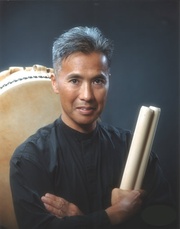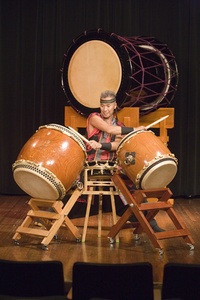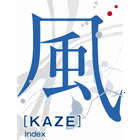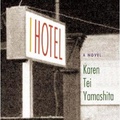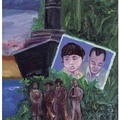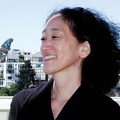There is a museum called Taikokan (Drum Museum) in Asakusa, Tokyo. While most museums do not allow you to touch the exhibits, here you can play drums from all over the world as you like. This is a rare museum built in 1987 by Miyamoto Uonosuke Shoten, a famous Japanese drum store.
Chie Ochi, former head of the Taiko Museum, once participated in the Taiko Conference held in Los Angeles. The Taiko Conference began in 1997 and has grown in size and content with each passing event. Ochi said that it was a bipartisan gathering of various schools of drumming, and that it was an event that could only be held in America, where partisanship is weak.
Kenny Endo is a Japanese-American taiko drummer who has a strong relationship with Miyamoto Uonosuke Shoten. The store has been involved in the production of Kenny's CDs and always provides accommodations for him when he comes to Tokyo.
When he came to Japan some time ago, we had dinner together at Arizona Kitchen in Asakusa. It is a famous restaurant in Asakusa that was frequented by Kafu Nagai, who wrote "Amerika Monogatari", and even today, Kafu's photo is displayed inside the restaurant. Kenny is a very gentle person, and the president of Miyamoto Uonosuke Shoten seems to like his personality.
In North America, the founder Seiichi Tanaka could be considered the first generation, his disciple Kenny and others the second generation, and Kenny's disciple Masato Baba and others the third generation. In this article, I would like to take a look at three generations of North American wadaiko, focusing on Kenny Endo.
Early days in America
The history of wadaiko in North America began in 1968 with Seiichi Tanaka, who began teaching wadaiko in San Francisco.
Tanaka, who grew up in Nagano Prefecture, was familiar with Japanese drums from an early age, and when he was in junior high school, he tried to join the "Osuwa Taiko" led by Daihachi Oguchi, but was not allowed to join because the group was not open to the public. However, when he went to the United States in 1967 and expressed his desire to spread Japanese drums there, he was allowed to join, which led to the formation of the "San Francisco Taiko Dojo."
The following year, in 1969, Kinnara Daiko was founded at Senshinji Temple in Los Angeles by Masao Kodani, a third-generation Japanese missionary, and Johnny Mori, who played taiko drums in the fusion band Hiroshima, which was formed in 1974. Kinnara is one of the guardian deities of Buddhism and the god of music. It's a fitting name for a group born from a temple.
Unlike Tanaka, who valued spirituality and demonstrated strong leadership, Kinnara Taiko had no firm leader. There was no hierarchy in the relationships. In the beginning, the way they played the taiko was modeled on Toshiro Mifune, who played the taiko in "The Life of a Hobbit." By coincidence, the two groups were born in California at the same time, but due to differences in their ways of thinking, there was a lot of friction between them.
Kinnara Taiko's greatest achievement is undoubtedly the idea of making Japanese drums using wine barrels. Tanaka, who was born in Japan, was impressed by this idea without even realizing it. This idea led to the spread of taiko drums throughout the United States.
In the 1970s, the San Jose Taiko Group was founded. Like in Los Angeles, it was organized by a Buddhist church and was made up of third-generation Japanese-Americans, but they received technical training from Tanaka of San Francisco.
In 1979, "Sou Daiko" (Monk Taiko) was born in New York. This group was also taught by Seiichi Tanaka, and we will refer to this period as the first generation.
If we compare the era of the first generation with the social situation in America, it coincides with the time when Asian Americans were awakening to their own identity and demanding the establishment of Asian American studies departments in universities. Considering that for Japanese Americans, wadaiko was a way to become aware of and express their ethnicity, and also to break stereotypes, the emergence of Seiichi Tanaka, although coincidental, was very timely.
It is also interesting that two unconventional taiko groups were formed in Japan at the same time: Ondekoza was formed in Sado in 1969, and Kodo branched off from it in 1981. Both groups continue to have a strong influence on young people in Japan and in America, including Japanese Americans.
Inspired by Japanese drums, he visits Japan
The second generation is the generation centered around Kenny Endo, who was introduced at the beginning of this article, and is the group that was founded in the 1980s and 1990s. Kenny was born in Los Angeles in 1953. His father was a first-generation Japanese drummer and his mother was a second-generation Japanese drummer, so he was second-generation Japanese drummer from his father's perspective, third-generation Japanese drummer from his mother's perspective, and 2.5-generation Japanese drummer.
Kenny loved drums from an early age, and was already taking drum lessons when he was in junior high school. In high school, he formed a jazz band and began performing, and in college, he earned money as a drummer to pay for his tuition. It was in 1973, during his second year of college, that he first encountered Japanese drums. He was shocked when he heard a performance by the San Francisco Taiko Dojo in San Jose.
That same year, Kenny had the opportunity to work on a Native American reservation, where he learned about their music and social situation and realized that he should learn about the culture of his own roots.
Two years later, in 1975, he finally knocked on the door of Kinnara Taiko in Los Angeles and stepped into the world of Japanese drums. The following year, he graduated from UCLA (University of California, Los Angeles) and moved to San Francisco, where he studied under Tanaka at the San Francisco Taiko Dojo. For the next five years, Kenny studied Japanese drums and made a living as a drummer, but he felt the need to choose one or the other, and chose Japanese drums. He then stayed in Japan for ten years from 1980 to further his studies.
Kenny first studied under Oguchi Daihachi of Osuwa Taiko in Nagano Prefecture, where Tanaka had studied. Oguchi invented the group Kumi Taiko in the 1950s, completely changing the history of taiko. Until then, taiko performances were done by one or two people. Six months later, Kenny moved to Tokyo to study Oedo Sukeroku Taiko, which has a fast tempo and invented diagonal striking. In 1981, he became a student of Hogakubayashi under Mochizuki Saburō, and in 1987 he was given the name Mochizuki Taijirō, becoming the first foreigner to receive the title.
In 1982, he became a member of the Sukeroku Taiko troupe and toured as a professional wadaiko drummer from Hokkaido to Kagoshima before returning to the United States in 1990.
What started out as a short stay of just one or two years turned into a long 10 years. He was so fascinated by the profound world of Japanese drumming that he still receives lessons from Mochizuki whenever he visits Japan.
*This article is a reprint of the 12th installment of the column series "From the Perspectives of Two Countries" in Renso Publishing 's online magazine "Kaze," which features information about new books, such as articles linking new books to current issues and daily topics, as well as monthly bestsellers and review columns of new books.
© 2010 Association Press and Tatsuya Sudo


